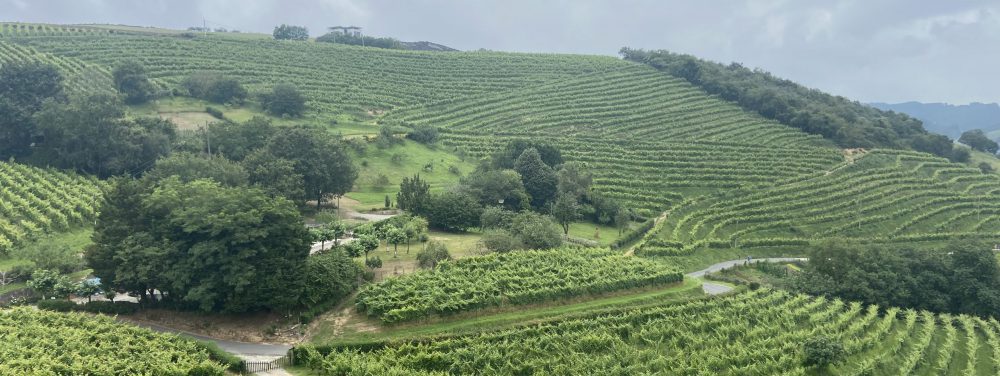If I could describe my study abroad experience in San Sebastián with just one word, it would undoubtedly be “opportunities.” This enchanting city in the Basque Country opened doors I never imagined, offering a wealth of experiences that expanded my worldview, deepened my appreciation for different cultures, and allowed me to forge connections that will last a lifetime.

Our journey to San Sebastián didn’t exactly start on a high note. What was meant to be an exciting beginning turned into a chaotic adventure of lost luggage, delayed and canceled flights, and unavailable bikes. The frustration of our travel mishaps cast a shadow over our initial excitement, and the sour taste lingered as we finally made our way to our hotel. But as with many things in life, first impressions can be deceiving, and San Sebastián had much more in store for us than we could have anticipated.
The morning after our arrival, we walked through the streets to our first Spanish class, still reeling from the exhausting journey. But as we strolled past the picturesque buildings, charming plazas, and vibrant markets, the beauty of San Sebastián began to reveal itself. The city, with its stunning coastline and majestic mountains, was a feast for our senses. Every turn seemed to offer a new breathtaking view or an intriguing corner to explore. It was clear that our study abroad experience was going to be much more than just an academic pursuit…

At Lacunza, our Spanish school, we were quickly divided into classes based on our proficiency levels. Some of us were nervous about being placed in new classes, especially in a foreign country where everything felt unfamiliar. However, those initial jitters quickly went away as we settled into our new routine. The classroom became a melting pot of cultures, with students from all corners of the globe. I met incredible people—fellow Americans as well as students from the Netherlands, Korea, Gibraltar, and many other places I never dreamed I’d have the chance to connect with. These friendships, born out of shared experiences and mutual curiosity, enriched my understanding of the world and provided new perspectives on life.
San Sebastián is a city that caters to all kinds of interests, which made it perfect for our diverse group. Whether someone preferred the tranquility of the beach, the thrill of hiking in the nearby mountains, or the challenge of surfing the Atlantic waves, there was something for everyone. Some of us found solace in early morning runs, others in exploring the winding streets filled with shops and cafes. And for the more adventurous, the waves at Zurriola Beach beckoned, offering a chance to try surfing in one of Europe’s most famous surf spots. The city encouraged us to step out of our comfort zones and try new things, making every day a fresh opportunity to discover more about ourselves and the world around us.
One of the most delightful aspects of San Sebastián is its food, particularly the pintxos—small, flavorful bites that are the pride of the Basque Country. Every Thursday, the city’s bars participated in “Pintxo Pote,” where for just 3 to 3.5 euros, you could enjoy a drink and a pintxo of your choice. These evenings became a highlight of our time in San Sebastián, as we gathered together to sample the city’s culinary offerings. Pintxo Pote was more than just a chance to eat well; it was an opportunity to immerse ourselves in the local culture, to meet new people, and to experience the city’s vibrant social scene. Even when the lines were long, the anticipation of tasting a new pintxo kept the excitement alive. And if we missed out on something one week, there was always the promise of another Thursday, another bar, another chance.
As mentioned before, Donostia – San Sebastián is part of the Basque Country, a region with a rich and unique history. To better understand the culture, we visited the San Telmo Museum, which offered fascinating insights into the Basque people’s past and present. We also ventured beyond the city, taking day trips to nearby towns like Biarritz and Saint-Jean-de-Luz in France. These excursions allowed us to fully immerse ourselves in the region’s culture and even indulge in some of France’s famous croissants and chocolates (they were delicious) . Learning about the Basque language, which is unlike any other language in the world, was another highlight. Although I initially thought I might find some similarities with other languages I knew, I quickly realized that Basque was in a league of its own, and mastering it would require far more than just a few classes.

Reflecting on our study abroad experience, it’s clear that while our trip didn’t start as we had hoped, the challenges we faced only made the rewards that much sweeter. San Sebastián offered us countless opportunities to grow, learn, and explore, transforming us into wiser, more well-rounded, and curious individuals. The city welcomed us with open arms, and in return, we embraced everything it had to offer. What began as a chaotic journey ended up being one of the most enriching and transformative experiences of our lives—a true testament to the power of seizing opportunities, even when they come wrapped in quite unexpected packages.
